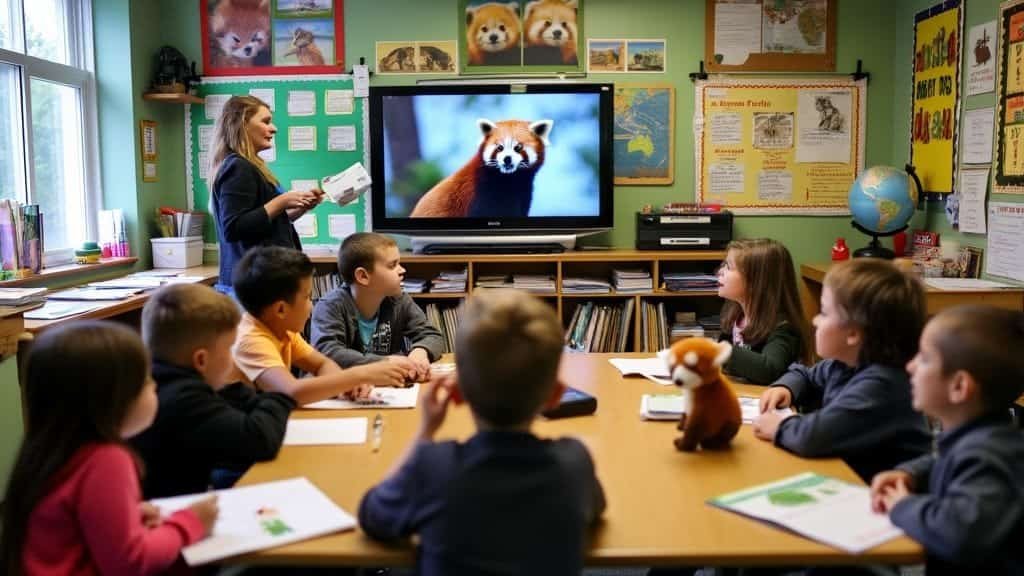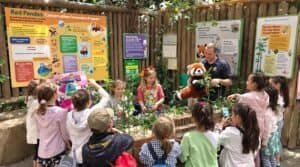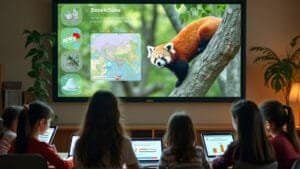Introduction
Red pandas, with their status as a beloved and endangered species, provide an engaging and educational way for schools to teach students about biodiversity, conservation, and sustainability
Schools are increasingly incorporating red pandas into their environmental education curriculums through hands-on activities, partnerships with zoos, and digital resources. From understanding ecosystems to learning about the impact of climate change, red pandas help students grasp key environmental concepts in a way that’s both accessible and inspiring
In this article, we will explore how red pandas are used in various educational programs, projects, and lessons to foster environmental awareness
Red Pandas as a Tool for Teaching Biodiversity
Red pandas have become an effective educational tool in teaching students about biodiversity. As an endangered species native to the eastern Himalayas and southwestern China, red pandas represent an opportunity to introduce students to key concepts about ecosystems, species conservation, and the interconnectedness of life on Earth
By focusing on the challenges faced by red pandas, educators can help students understand broader environmental issues, such as habitat loss, climate change, and the importance of protecting biodiversity
Understanding Red Panda Habitats and Ecosystems
One of the most common ways schools use red pandas to teach biodiversity is by exploring their natural habitats. Red pandas thrive in temperate forests that are rich in bamboo, a plant that makes up a significant portion of their diet
Teachers often include lessons on the ecosystems where red pandas live, helping students understand how different species depend on their environment for survival. By studying the plants, animals, and climate that make up these ecosystems, students learn about the delicate balance that sustains life in these regions
These lessons can include geography, where students map out the red panda’s habitat range, and biology, where they explore the characteristics of the temperate forests. Schools might use documentaries or virtual reality (VR) experiences to give students a sense of what these environments look like, making the subject matter more engaging
Understanding the habitats of red pandas also offers an entry point into discussions about deforestation, poaching, and other human impacts on wildlife, which in turn leads to conversations about sustainability and conservation efforts
Lessons on Endangered Species and Conservation
Red pandas are listed as endangered by the International Union for Conservation of Nature (IUCN), which makes them a powerful symbol for teaching students about the importance of protecting endangered species
In many environmental curriculums, red pandas are used to illustrate the risks species face in the wild, including habitat loss, illegal hunting, and environmental changes due to climate change. Schools often incorporate this into larger discussions about the IUCN Red List and the factors that contribute to species becoming vulnerable or endangered
Educators may assign projects that ask students to research the specific threats to red pandas and propose solutions, whether through conservation efforts, habitat restoration, or changes in policy. This helps students develop critical thinking skills while gaining an appreciation for the complex challenges of wildlife protection
Additionally, students may be encouraged to participate in activities like fundraising for conservation organizations or campaigns to raise awareness about endangered species
Red Pandas as Symbols of Biodiversity
Red pandas are increasingly being used as symbolic representations of biodiversity, helping students understand the importance of maintaining diverse ecosystems. As a charismatic species that is easy to connect with, red pandas can help humanize the abstract concept of biodiversity
When students learn about red pandas and their role in their ecosystem, they also learn about the many other species that depend on the same habitats, such as birds, insects, and plants
By using red pandas to illustrate the concept of biodiversity, teachers can encourage students to think about how all species—big and small—are interconnected. Students often find it easier to engage with topics like ecosystem collapse and species extinction when they can focus on a familiar, beloved animal like the red panda
This approach can also be paired with lessons on the importance of preserving genetic diversity, ecological niches, and the long-term benefits of maintaining healthy, thriving ecosystems
Red Pandas in Conservation Education Programs
Conservation education programs centered around red pandas offer students the chance to engage in hands-on learning and gain a deeper understanding of wildlife protection
Many schools incorporate these programs as part of their science or environmental studies curricula, often partnering with zoos, wildlife organizations, and conservation groups to provide students with direct experiences related to red panda conservation efforts
These programs foster a connection between students and the natural world while teaching them about the challenges and strategies involved in preserving endangered species
School Partnerships with Zoos for Red Panda Conservation
One of the most impactful ways schools introduce students to red panda conservation is through partnerships with local zoos and wildlife organizations
Zoos that house red pandas often have education outreach programs designed to teach children about the species’ biology, behavior, and the efforts being made to protect them. These collaborations can include field trips where students have the opportunity to see red pandas up close, learn from zookeepers, and even participate in interactive activities such as feeding demonstrations or habitat tours
In addition to field trips, many zoos offer classroom resources that align with school curriculums. For example, students may engage with materials that explore the lifecycle of red pandas, their role in the ecosystem, and the conservation challenges they face
These programs often highlight the importance of global conservation efforts, and students are encouraged to think critically about the human activities that threaten wildlife, including deforestation and poaching
Schools can also host virtual sessions with conservation experts, allowing students to ask questions and learn from professionals who are actively working to protect red pandas
Hands-On Learning Activities Focused on Red Pandas
Educators often design hands-on activities that immerse students in red panda conservation. These activities can range from creating red panda habitats in the classroom to engaging in citizen science projects that support wildlife monitoring efforts
For example, students might create models of a red panda’s forest habitat, complete with bamboo and other plant species that are crucial to their survival. This helps students visualize how ecosystems function and the impact that habitat destruction can have on species
Another common activity is having students participate in simulated wildlife tracking or data collection projects. In these exercises, students act as conservationists tracking red panda populations or monitoring environmental factors such as deforestation rates
By role-playing as field scientists, students gain a better understanding of how conservationists gather and analyze data to support wildlife protection. These projects often include elements of math and science, as students are required to interpret data and draw conclusions based on their findings
Red Pandas in Sustainability and Climate Education
Red pandas are not only a vehicle for teaching about endangered species but also for broader lessons on sustainability and climate change. Their endangered status is tied closely to habitat loss caused by deforestation, climate change, and agricultural encroachment
Schools use red pandas to teach students about the importance of sustainable practices, such as responsible consumption of natural resources, reducing carbon footprints, and protecting forests that are vital to red panda survival
Lessons often emphasize the interconnection between global climate change and species survival, with red pandas serving as a case study for understanding how rising temperatures and changing weather patterns affect vulnerable species
Educators may guide students through discussions about how individual actions, such as reducing waste, supporting renewable energy, and participating in conservation efforts, can help protect species like the red panda. By connecting personal responsibility with the broader environmental impact, students learn the significance of adopting sustainable behaviors to support both local and global ecosystems
Classroom Activities and Projects Involving Red Pandas
Schools frequently incorporate red pandas into their environmental education curriculum through a variety of creative activities and projects. These activities not only engage students in learning about conservation and biodiversity but also foster a sense of personal connection with wildlife
From art projects to interactive digital tools, red pandas provide an appealing subject for lessons that combine creativity with science, helping students of all ages explore key environmental concepts
Red Panda-Themed Projects and Art
Art projects are a popular way for students to explore the beauty and uniqueness of red pandas while learning about their endangered status
Many teachers use red panda-themed activities to encourage students to express their understanding of the animal and its environment through creative mediums. For example, students might create drawings, sculptures, or dioramas that depict red pandas in their natural habitats
These projects help reinforce lessons on ecosystems and the importance of preserving natural environments for species survival
In some schools, red panda art contests or collaborative mural projects are used to raise awareness about endangered species. Students may work together to design posters or educational displays about red panda conservation, which can be presented at school events or shared with the wider community
This approach not only helps students engage with the subject matter but also provides them with an opportunity to advocate for conservation efforts in their own school or neighborhood
Interactive Digital Resources for Red Panda Education
Digital resources have become increasingly important in environmental education, providing students with access to interactive tools that bring red panda conservation to life
Many schools use online platforms, apps, and virtual experiences to teach students about red pandas and other endangered species. For example, educational websites and apps often feature virtual habitats where students can “explore” the forests where red pandas live, learning about the animals’ diet, behavior, and threats to their survival
Some digital resources allow students to simulate the role of conservationists, where they can track red panda populations, manage habitats, and implement conservation strategies
These interactive tools teach problem-solving and critical thinking skills, as students must make decisions based on real-world data and scenarios. For example, a popular online simulation may ask students to balance the needs of local communities with efforts to conserve red panda habitats, mirroring the complexities faced by conservationists in the field
Field Trips and Virtual Zoo Experiences Featuring Red Pandas
Field trips to zoos and wildlife sanctuaries are a classic way for students to learn about red pandas firsthand. Many zoos offer special programs where students can observe red pandas up close and learn about their behavior, habitat needs, and the conservation challenges they face
These visits often include educational talks from zookeepers or wildlife experts, who explain how zoos participate in global conservation efforts, such as breeding programs and habitat preservation initiatives
For schools that may not have access to zoos or wildlife centers, virtual zoo experiences provide an innovative alternative. Many zoos and conservation organizations now offer live-streamed red panda exhibits, virtual tours, and Q&A sessions with wildlife experts
These virtual experiences allow students to observe red pandas in real time and ask questions about their care and conservation. By providing an immersive and interactive experience, virtual zoo visits enable schools to incorporate red panda education into their curriculum even from a distance
Conclusion
Incorporating red pandas into environmental education curriculums offers schools a dynamic way to engage students in topics like biodiversity, conservation, and sustainability. From classroom projects and digital resources to partnerships with zoos, red pandas serve as an appealing and accessible gateway to understanding critical environmental issues
Their endangered status provides a relatable example for lessons on the impact of habitat loss, climate change, and conservation efforts. Whether through creative art projects, hands-on learning activities, or virtual zoo experiences, students gain a deeper appreciation for wildlife and the interconnectedness of ecosystems
As schools continue to explore new ways to teach environmental responsibility, red pandas will remain a valuable educational tool that inspires both awareness and action









